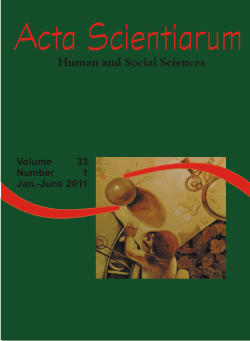<b>Formative aspects within the conflict between gentilic faith and city-state laws in <em>Antigone</em></b> - doi: 10.4025/actascihumansoc.v33i1.11755
Keywords:
Sophocles, man, tradition, education
Abstract
Having as a frame of reference certain formative aspects in Antigone by Sophocles, this paper intends to discuss how the dramatist, in the aforementioned play, represents the process of transition between myth and reason — gentilic faith and City-State laws — which the Greek society of the 8-5th centuries B.C. faced. The reflection proposed by Sophocles has as its guiding principle the acts of princess Antigone against an edict by King Creon, concerning the burial ceremony of her brother, Polynices. As the protagonist is backed up by the religion of the patriarchal society, the antagonist is the defender of the City-State laws. Within this conflict, not only did Sophocles make use of his character’s issues, but also those of the Greek Man during that transitional time. Thus, in Antigone, the poet presents, though not intentionally, the formative ideal that would fulfill the necessities of the Hellenic society of his time. Therefore, in order to develop this approach, a methodology that contemplates the Greek society of his time is required, as this is the basis to discuss the formative process inherent in Sophoclean drama.Downloads
Download data is not yet available.
Published
2011-03-30
How to Cite
Melo, J. J. P., & Fernandes Gomes, R. W. (2011). <b>Formative aspects within the conflict between gentilic faith and city-state laws in <em>Antigone</em></b> - doi: 10.4025/actascihumansoc.v33i1.11755. Acta Scientiarum. Human and Social Sciences, 33(1), 117-122. https://doi.org/10.4025/actascihumansoc.v33i1.11755
Issue
Section
Education History
DECLARATION OF ORIGINALITY AND COPYRIGHTS
I Declare that current article is original and has not been submitted for publication, in part or in whole, to any other national or international journal.
The copyrights belong exclusively to the authors. Published content is licensed under Creative Commons Attribution 4.0 (CC BY 4.0) guidelines, which allows sharing (copy and distribution of the material in any medium or format) and adaptation (remix, transform, and build upon the material) for any purpose, even commercially, under the terms of attribution.
Read this link for further information on how to use CC BY 4.0 properly.























